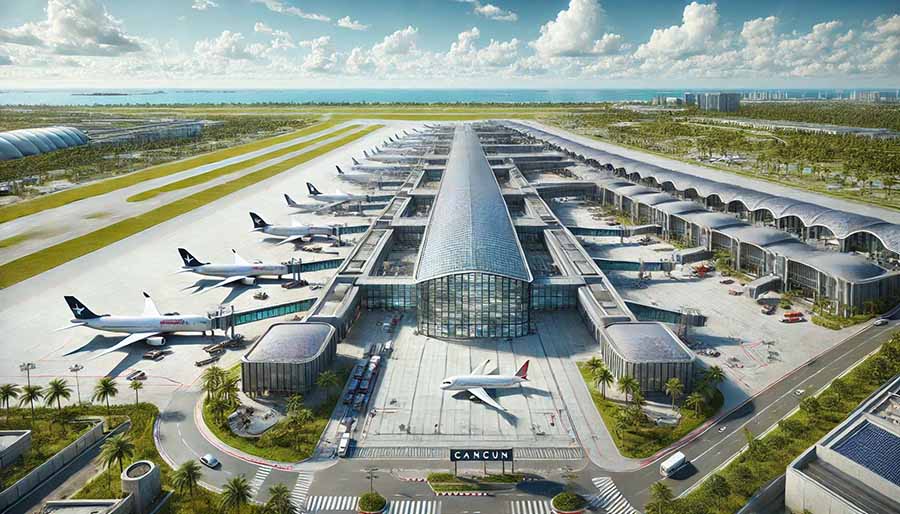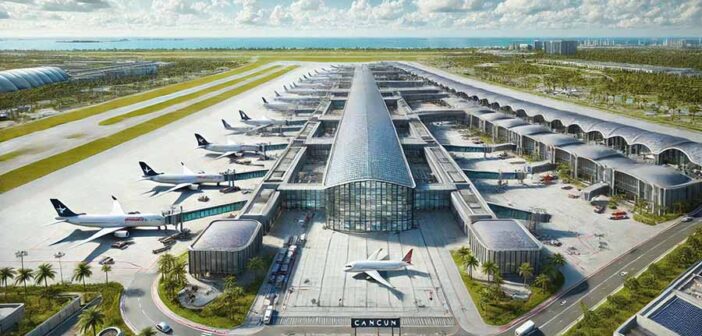
Cancْún Airport Offers Efficient Gateway to Mexico’s CaribbeanCANCعN – Cancْún International Airport, known as CUN, stands as Mexico’s second busiest airport, handling over 30 million passengers annually with a modern four-terminal setup. Located 16 kilometres southwest of Cancْún’s hotel zone in Quintana Roo, it connects travellers to over 100 destinations across the Americas and Europe, served by airlines like American Airlines, Air Canada, and Volaris. Operated by Grupo Aeroportuario del Sureste, the airport provides a practical experience for those heading to the Mexican Caribbean, Riviera Maya, and Yucatلn Peninsula.
Accessing the airport from Cancْún is straightforward, with several transport options available. ADO buses depart every 30 to 45 minutes from all terminals, reaching downtown Cancْún in about 30 minutes for €5 to €10, though fares at Terminal 4 can be higher. Pre-booked private shuttles, offered by companies like Best Day or Lomas Travel, provide direct transfers to hotels in 20 to 40 minutes for €20 to €50, while official airport taxis charge similar rates but are less recommended due to cost. Car rental agencies, including Hertz and Europcar, are located in each terminal, and parking facilities offer short- and long-term options starting at €2 per hour.
A railway station across Federal Highway 180 serves destinations like Tulum and Mérida, but access requires a shuttle or taxi. Passengers should arrive three hours before international flights and two hours before domestic ones to account for security and immigration processes.
The airport’s layout comprises four terminals: Terminal 1 for charter and private flights, Terminal 2 for domestic and some international flights, Terminal 3 for major US, Canadian, and European carriers, and Terminal 4 for both domestic and international routes.
A free shuttle runs every 10 to 15 minutes between terminals, keeping transfers under 10 minutes. Terminal 3, with 21 gates, and Terminal 4, with 14 gates, feature modern designs with clear signage, though Terminal 2 can feel dated. Peak seasons, particularly mid-December to April, can lead to long queues at immigration and security, especially in Terminals 2 and 3, due to high tourist volumes. Baggage claim delays, sometimes exceeding an hour, may occur due to limited carousels or system issues, so passengers should monitor updates via the airport’s website or Flightradar24.
Dining and retail options are plentiful, particularly in Terminals 3 and 4. Duty-free shops by Heinemann offer souvenirs and luxury goods, while stores like 7-Eleven and local outlets sell travel essentials. Restaurants range from fast-food chains like McDonald’s to sit-down venues serving Mexican and international cuisine, with a meal costing around €5 to €10. Cafes like Starbucks are open 24/7, but prices are higher than city averages. Three lounges—MERA Business Lounge in Terminals 2, 3, and 4, and The Lounge by Air Transat in Terminal 4—provide Wi-Fi, snacks, and showers for €35 to €40, accessible via Priority Pass. Crowded dining areas during peak times suggest eating before security.
Facilities include free Wi-Fi across all terminals, though connections may slow during busy periods. Charging stations, ATMs, currency exchange, and baggage wrapping are available, but luggage storage is limited to nearby hotels like Le Meridien, a five-minute drive from Terminal 3. Accessibility is supported with ramps, lifts, and assistance services bookable 48 hours in advance. Other amenities include prayer rooms, a pharmacy, and baby-changing facilities, though seating in Terminal 2 can be scarce. Onsite hotels, like the Courtyard by Marriott, offer convenient stays with shuttle access.
On-time performance is generally reliable, with Terminal 3’s advanced systems supporting efficient operations. Delays often stem from immigration system failures, airline equipment issues, or weather conditions like hurricanes. Recent social media posts mention delays due to passport scanning issues and slow baggage delivery, particularly in Terminal 3. Passengers can check real-time updates via in-terminal displays. As a hub for Volaris and Viva, Cancْún facilitates connections, with minimum transfer times of 40 minutes within the same terminal and 60 to 80 minutes between terminals. Airside transfers are available, but self-transferring passengers may need to clear customs and recheck luggage, which can slow connections, especially for non-Schengen flights.
Cancْún Airport’s modern infrastructure, extensive transport options, and ample amenities make it a practical choice for travellers. Ongoing expansions, like Terminal 4’s eco-friendly upgrades, aim to enhance capacity. While peak-season congestion and occasional system failures pose challenges, the airport’s services ensure a smooth journey to Mexico’s Caribbean coast.




